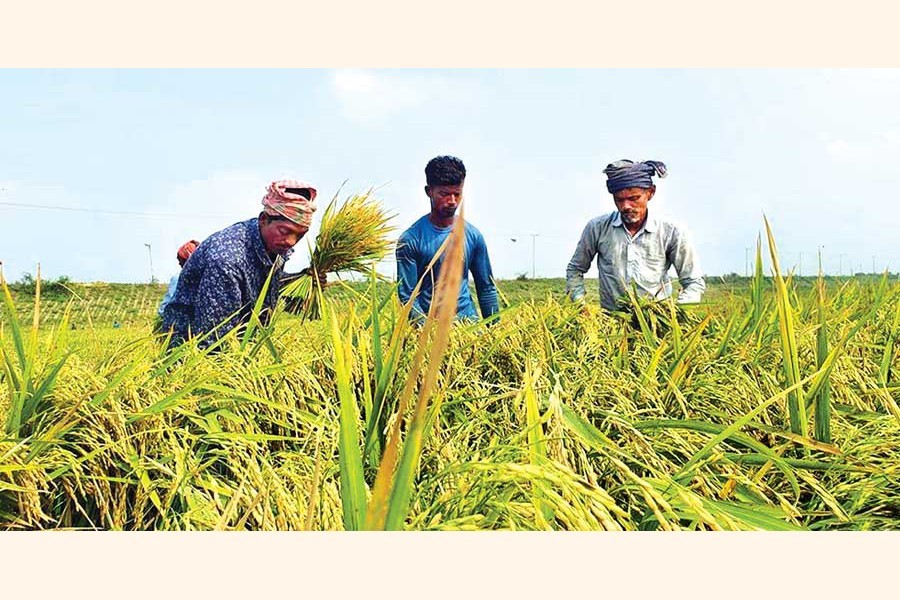
Published :
Updated :

Poor agri-mechanisation has posed a fresh challenge to the current Boro crop harvest in Bangladesh for labour scarcity in the wake of the COVID-19 pandemic, agriculturists have said.
They have put emphasis on enhancing farm machinery like combined harvester and ripper to help cope with agri-worker shortages.
Though the government has initiated to mobilise labourers in crisis-riddled districts, the arrangement is not enough to meet the demand, said experts.
Boro is the major cropping season producing 55 per cent of rice the country consumes.
April to June is the peak harvest time of Boro crop and also of summer vegetables for which the period is most important for the country's economy.
The countrywide shutdown, as a precaution against the pandemic, has virtually turned into a bane for the farm sector for a dearth of labourers.
"As ingathering has already begun at haor and other lowlands, a lack of modern farm machinery has deepended labour crisis", said agronomist Golam Hafeez Kennedy.
He said the farm community need an additional 1.8 million labourers this Boro-harvesting season.
Mr Kennedy said haor Boro growers are more dependent on migrated workers as they usually need 45,000 to 50,000 labouers a day between April 15 and 30.
A lack of usage of modern farm machinery like combined harvester and ripper has intensified labour problem.
He said the country has made a significant progress in farm mechanisation for ploughing and irrigation but a little progress in plantation and harvest.
The agronomist said poor financial condition of farmers and lack of government initiatives have caused low development in post-harvest farm mechanisation.
He said the government has allocated Tk 2.0 billion for farm mechanisation in recent weeks which should be spent immediately on farm machinery.
A combined harvester is too costly for a farmer. So, government should provide such equipment for free to every union council, he observed.
The union council can render services to farmers in exchange of an amount set by the Deapartment of Agriculture Extension (DAE).
Mr Kennedy suggested that the government provide at least 1,000 combined harvesters at Tk 2.0 billion.
Though the number is also much lower than the demand, it should be managed for a better production outlook.
Agriculture ministry additional secretary (extension wing) Md Hasanuzzaman Kallol said the government has provided 180 harvesters and 137 rippers through special arrangements for haor farmers.
The local administration and the DAE have jointly arranged migratory farm workers for haor and other areas to reap paddy and other crops, he told the FE.
More than 40,000 farm labourers have been sent to haor and other lowlands from Rangpur, Rajshahi, Mymensingh, Sylhet, Faridpur and Chattogram regions in the past 10 days, Mr Kallol stated.
The ministry with the help of the local administrations and the DAE have also arranged their transportation and accommodation in different districts.
ACI Motors Ltd executive director Subrata Ranjan Das said the country has a demand for 0.1 million units of harvesters but availability is still below 1,500 units.
Farmers are using around 50,000 tractors and 700,000 power tillers for 95-per cent mechanised ploughing.
But the use of rippers and combined harvesters or rice planters is very low, which is now obligatory to make the total farming process mechanised.
Mr Ranjan said there is a demand for rice planters is 0.2 million units, whereas farmers have only 950 units.
His company is selling Japanese Yanmar brand of combined harvester which costs Tk 2.5-2.8 million each.
A modern combined harvester can reap paddy of 3.5 hectares a day and can save Tk 15,700 per hectare a day, minimising the need for labourers.
Prof Monjurul Ahsan of farm power and machinery department at Bangladesh Agricultural University said the use of mini or combined harvesters that cut, thresh and bag grains simultaneously.
This could be a game-changing solution to farmers during this lockdown period through saving cost, time and human labour, he went on to say.
Mr Ahsan said a modern harvester can harvest, thresh or even package paddy of 3.5 hectares a day with only 61 labourers when doing things automatically.
But it needs 213 labourers when things are done in a traditional way, he added.
Mr Ahsan said farmers can buy such machinery with maximum 70 per cent of incentive but it is not enough.
Despite having such incentive, he said, a farmer needs an additional Tk 1.0 to 1.5 million to buy the machine which is not possible for the local peasantry.
The government should undertake measures to raise incentive so that farmers can buy modern equipment like combined harvester, ripper and transplanter to minimise labour shortages.


 For all latest news, follow The Financial Express Google News channel.
For all latest news, follow The Financial Express Google News channel.